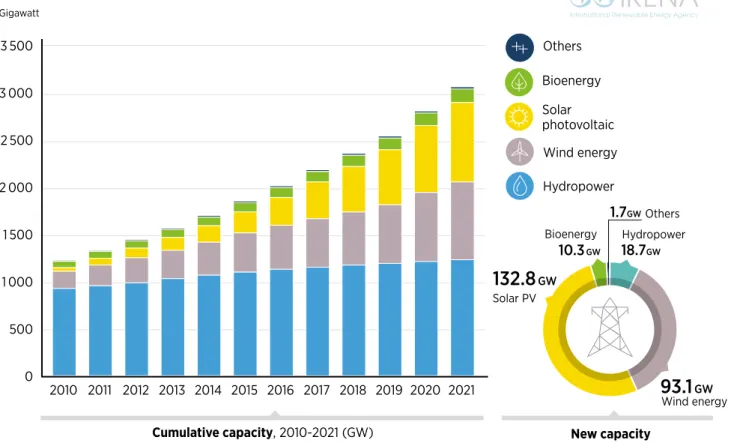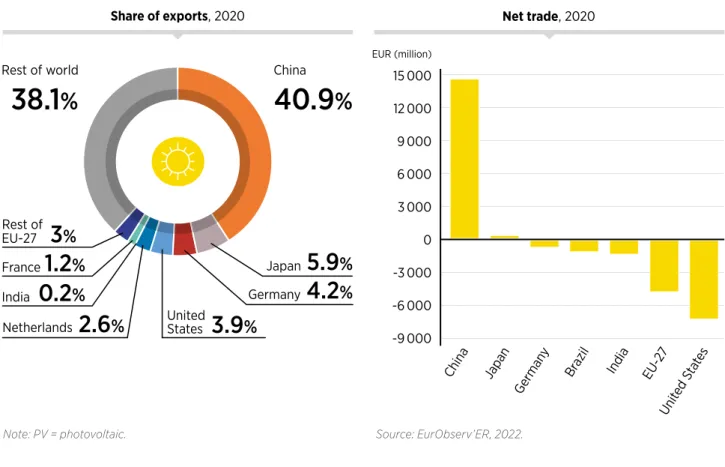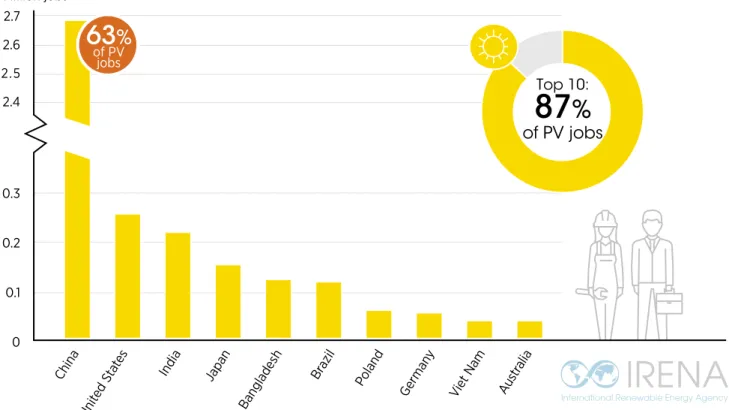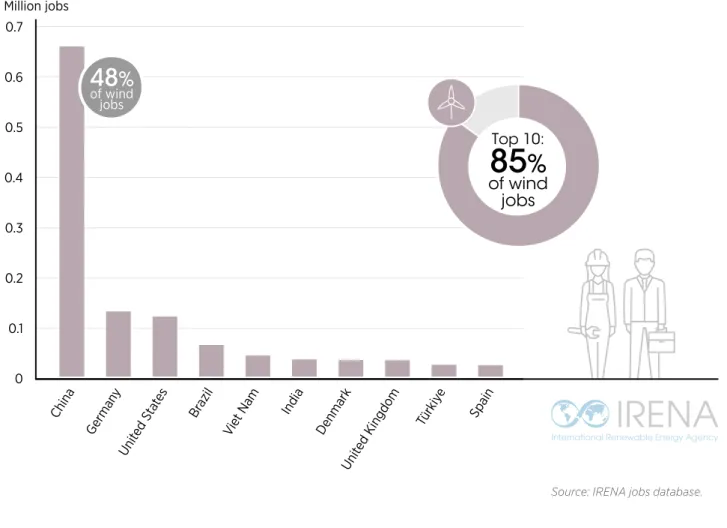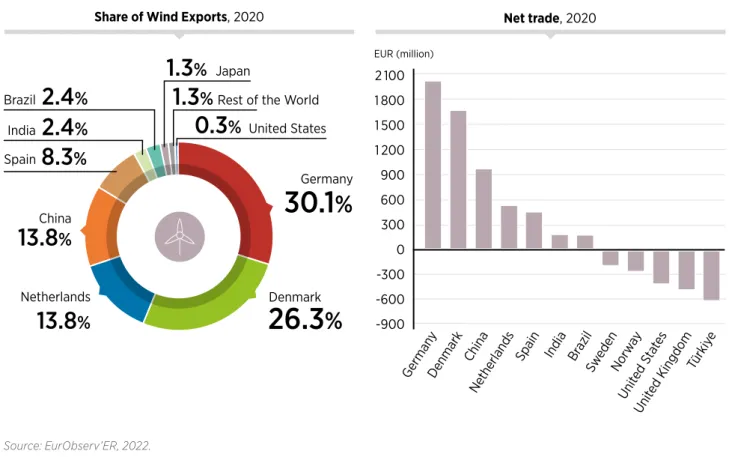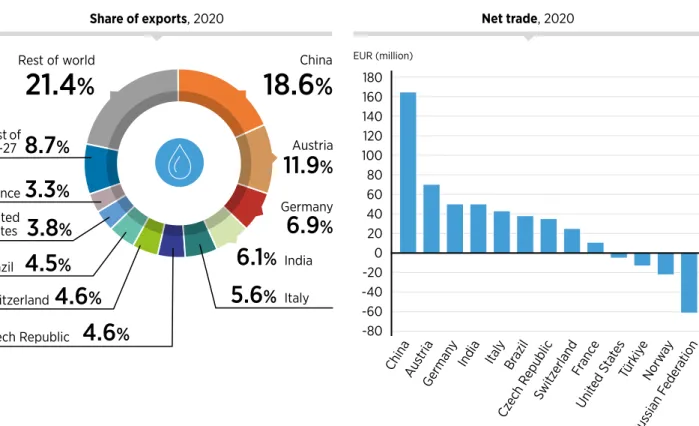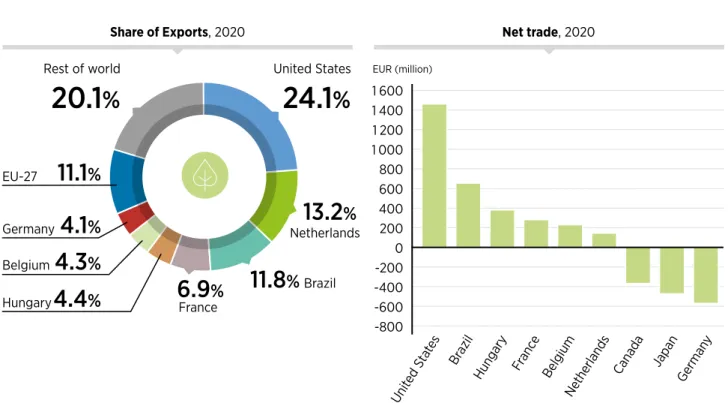Almost two-thirds of all renewable energy jobs are based in Asia, with China alone accounting for 42% of global jobs. It investigates job quality and related issues in the upstream and downstream segments of the renewable energy supply chain.
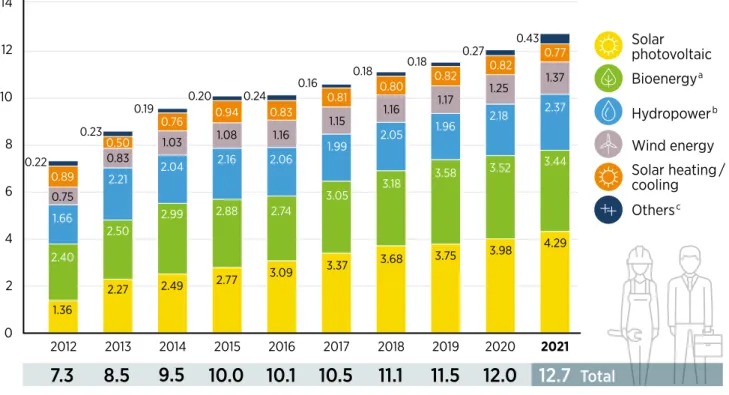
- Solar photovoltaic
- Wind
- Hydropower
- Liquid biofuels
- Off-grid renewables
Most of CHINA's renewable energy capacity increases in 2021 were in the PV and wind industries. They account for 8% of the nation's total solar PV generation costs, compared to 22% in the United States (US DOE, 2022b). Employment in the renewable energy sector continues to grow, particularly in the PV and wind industries.

Leading countries
It now has by far the largest cumulative installed offshore capacity in the world (IRENA, 2022a). The planned decrease in subsidies for offshore installations led to a sharp increase in the number of installations in 2021 and thus to a higher labor requirement.5 The increase in employment also reflects the fact that offshore installations require more labor input than facilities on the country. In the first three quarters of 2021, utility-scale solar PV facilities accounted for more than 70% of all U.S. installations; more labor-intensive residential installations represented less than 20% (Feldman et al., 2022).
Several coastal states in the United States are pursuing industrial and infrastructure policies and workforce development programs to support offshore wind development. Countries in EUROPE were home to a total of 1.5 million jobs in renewable energy, around 1.2 million of them in the 27 member states of the European Union (EU-27). The definition used by EurObserv'ER (2022) – the primary source for IRENA's estimates in the previous edition of the Annual Review – is more limited, but includes certain secondary activities (such as transport or warehouses).
Offshore wind – the Saint-Nazaire, Fécamp and Saint-Brieuc farms – accounted for around 5,200 jobs in 2020 (including 1,300 in manufacturing). IRENA estimates that jobs in the French wind industry (onshore and offshore) remained stable at around 22,000 in 2021.
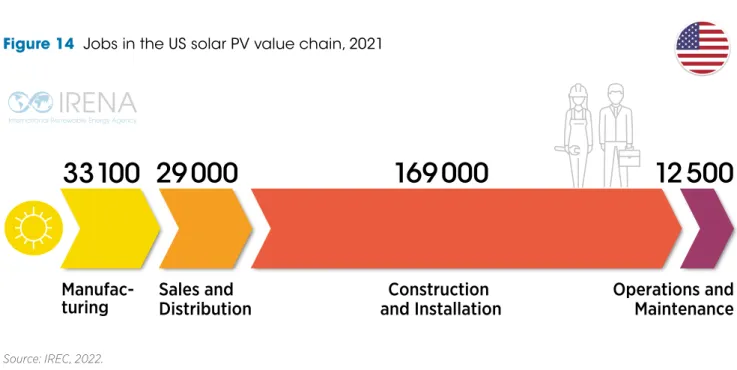
Other countries
In the agricultural supply chain for liquid biofuel (not included in the above total), IRENA estimates around 34,300 jobs. In 2021, the lack of installations, aside from limited roof additions, likely led to a significant reduction in the workforce. In the Pacific, AUSTRALIA completed some of its largest wind and solar projects in 2021, according to the Clean Energy Council (2022).
However, the long-term effects of the pandemic have caused employment in the renewable energy sector to decline by more than 25% in technologies such as solar PV, wind power and biomass. The company has more than 1,000 employees in the Democratic Republic of the Congo, Kenya, Rwanda and Togo. The company is based in the UK and its solar equipment is manufactured in China.
Of the estimated 49,600 people working in the country's DRE sector, 31% are in informal work situations (Power for All, 2022). Fossil fuel-based economies are vulnerable to disruptions in the flow of the fuels themselves (oil, gas and coal).
A changing supply chain landscape . 53
Security of supply – of finished products, key components such as semiconductors or critical raw materials for renewable energy – has become a concern in the context of ongoing supply chain disruptions, trade disputes and geopolitical rivalries. Policies adopted by a number of countries in the solar and wind industry include local content requirements; production tax credits; Rising costs from supply chain disruptions stemming from the COVID-19 crisis are complicating the picture, at least in the short term.
In Russia, the world's third largest nickel producer, Nornickle mining and refining activities contribute heavily to air and water pollution, affecting the livelihoods of indigenous communities in the Arctic (Stone, 2022). Because large-scale mining is capital intensive, it represents a relatively small share of employment in countries and communities endowed with key minerals for the energy transition. Artisanal and small-scale mining (ASM) is more labor intensive than large-scale mining and often takes place in the informal sector.
To advance decent work in the ASM sector, the ILO is implementing several development cooperation projects. One is the COTECCO project in the Democratic Republic of Congo, which aims to improve and strengthen the legal and policy framework to eliminate child labor in the ASM cobalt sector.
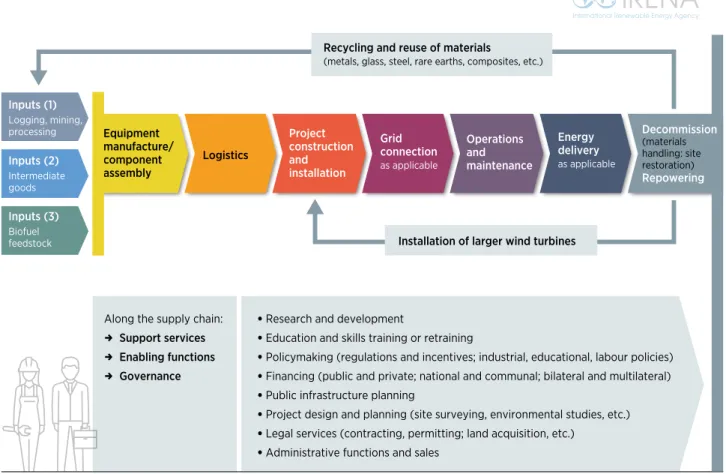
A circular economy approach to
Some types of renewable energy equipment, such as solar panels, are categorized as e-waste under European legislation. A large body of information on the challenges and opportunities to promote decent work in e-waste management could potentially inform the approach to managing waste from renewable energy infrastructure (ILO, 2019a, 2019e). In the UK, an estimated 40 jobs are created in collection and sorting for every 1,000 tonnes of e-waste (ILO, 2019a).
A circular economic transition in the renewable energy sector will inevitably have to be realized through cooperation between workers and companies. Reduce waste and pollution and improve working conditions in the production of renewable energy infrastructure. Such steps can ensure that the jobs created in this final stage of the renewable energy value chain comply with occupational health and safety standards.
The 2021 edition of Sustainable Energy and Jobs: Annual Review highlighted the need for such a holistic approach to make the just transition a reality. A key requirement is that jobs in renewable energy are decent jobs in terms of pay, working environment and other working conditions, job security and rights at work.
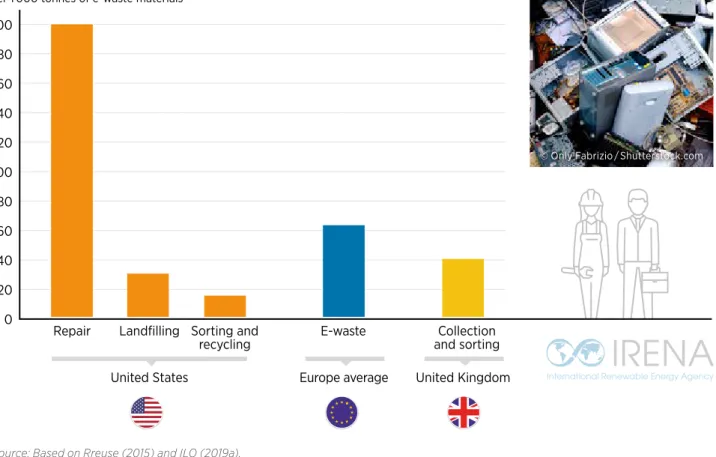
Challenges and opportunities
Keeping average global temperatures to 1.5°C will require a rapid and massive transformation of the world's energy system, including a massive scale-up of renewable energy installations, upgrading of electricity grids and other energy supply systems, creation of large-scale energy storage systems and many related measures – with enormous consequences for the industrial capacity along the supply chain and a broad structural basis for economies around the world. It must be addressed within a broad policy framework that includes industrial policies, education and skills training, labor market policies, diversity and inclusion strategies, and regional revitalization and social protection measures. It cited the need to address structural barriers (including dependence on fossil fuels, supply chain strengths and weaknesses, and trade patterns for raw materials and technology); overcome potential job failures as the energy transition unfolds; and support workforce diversity in ways that provide equal opportunities for men and women, youth, minorities and marginalized groups.
Labor standards are much stronger in industries with formalized structures than in the informal sector, where there is little social protection. Jobs in the utility sector tend to offer better pay and benefits than jobs in construction or in the agricultural supply chain. In early 2022, Denmark's Ørsted (one of the world's largest offshore wind developers) signed a national offshore wind agreement with North America's construction unions.
Built around a draft Labor Agreement and covering all Ørsted contractors and subcontractors, the pact sets an industry standard for wages, local training programs and occupational health and safety. For each project, it creates Workforce Equity Committees to prioritize the recruitment and retention of people of color, women and other disadvantaged groups, including gender non-conforming people.
A just transition for households
Paradoxically, global energy and income inequality is a key factor impeding climate action and slowing the energy transition. For the energy transition to be purely from a social and income distribution perspective, it must acknowledge and address the paradox of income and energy inequality. Studies assessing the potential employment impacts of the energy transition vary in numbers, but all point to a net global job gain (e.g. ILO, 2018; IRENA, 2022c).
Based on the findings in each setting, national just transition policy frameworks should be developed to accompany climate action, enabling economic and labor market restructuring and ensuring a just energy transition. Skills training, which is critical because skilled workers install, maintain and operate energy transition investments. A focus on human capital is justified, as the right skills are required to manufacture, install and maintain energy transition technologies.
As job creation in the energy transition is concentrated among middle-skilled occupations, the transition creates a great opportunity to create middle-class jobs. Of the nearly 25 million jobs that could be created under the ILO energy transition scenario by 2030, almost 16 million fall into the medium-skills category (ILO, 2019b).
An all-encompassing approach
There are also increasing employment opportunities (along with the challenges of how to provide decent jobs) in the upper parts of the renewable energy value chain and in the circular economy approach after projects reach the end of their life and are decommissioned. But most of the jobs created to date have been in a relatively small number of countries, led by China and including Brazil, India, the United States and EU member states. Due to their strengths in equipment manufacturing, engineering and a range of services along the value chain, some of these countries also dominate exports of renewable energy equipment.
IRENA's work points to the need for a comprehensive policy framework, based on holistic analysis (Figure 17). Such an approach starts with deploying, integrating and enabling policies within the renewable energy sector itself, but also includes specific policies and programs to leverage and strengthen industrial capabilities, improve infrastructure, build a skilled workforce and structurally reduce dependencies in the economy that can hinder the development of the economy. successful transition. However, supply chain disruptions caused by the pandemic continue, and new challenges – such as the impact on the energy sector of the war in Ukraine and rising trade barriers – have increased shipping costs, changed global trade patterns and led to commodity price volatility .30 Concerns about the security of supply of key intermediate products and a range of raw materials needed for the energy transition are becoming a growing problem, although the needs and perspectives of different regions of the world vary.
At the same time, there is tension between the desire for greater local production (and local value added) and the need to ensure that solar panels and wind turbines are affordable to encourage their increased use.
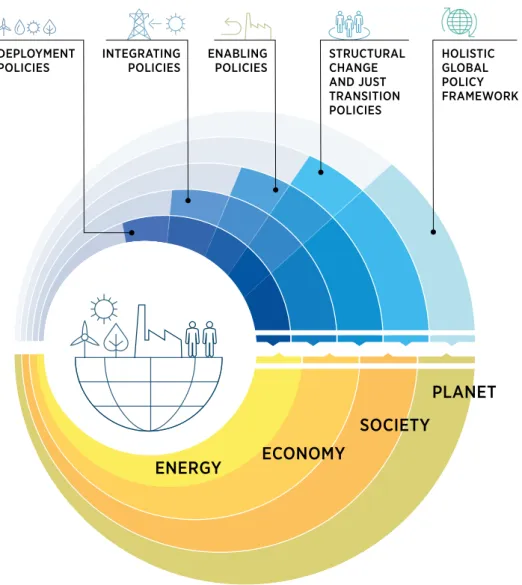
Future job estimates and socio-
ILO (2022b), "Labour standards", International Labour Organization, Genève, www.ilo.org/global/standards/lang--en/in dex.htm. A Global View, International Labour Organization, Genève, www.ilo.org/skills/pr ojects/WCMS_706922/lang--en/index.htm. IRENA (2022a), Renewable Capacity Statistics 2022, International Renewable Energy Agency, Abu Dhabi, https://www .irena.org/publications/2022/Apr/Renewable-Capacity-Statistics-2022.
IRENA (2022c), World Energy Transitions Outlook 2022: The 1.5°C Pathway, International Renewable Energy Agency, Abu Dhabi, www.irena.org/publications/2022/Mar/Wor ld-Energy-Transitions-Outlook-2022 . Biofuels Annual, US Department of Agriculture-Foreign Agricultural Service, The Hague, July 13, www.fas.usda.gov/data/european-union-biofuels-annual-2. USDA-FAS (2021a), Brazil: Biofuels Annual, US Department of Agriculture-Foreign Agricultural Service, Sao Paulo, August 30, www.fas.usda.gov/data/.
Foreign Agricultural Service, Kuala Lumpur, December 20, www.fas.usda.gov/data/ma laysia-biofuels-annual-4. USDA-FAS (2021g), China: Biofuels Annual, US Department of Agriculture-Foreign Agricultural Service, Beijing, September 13, www.fas.usda.gov/data/china-biofuels-an nual-7.

